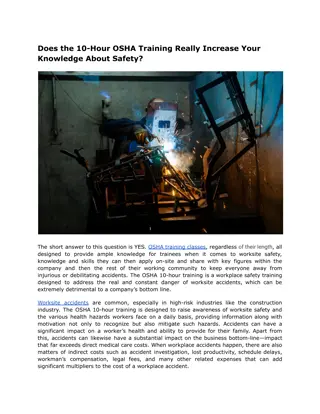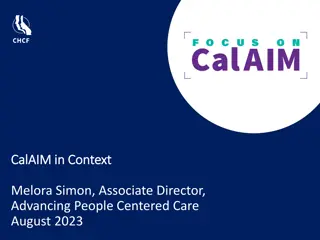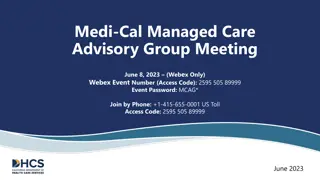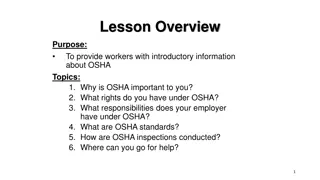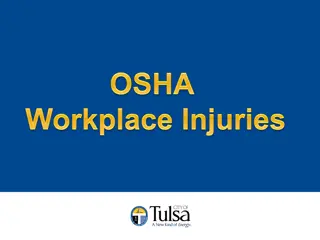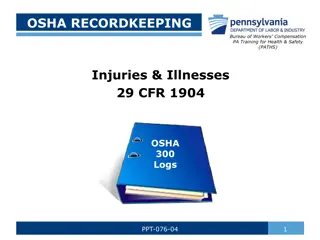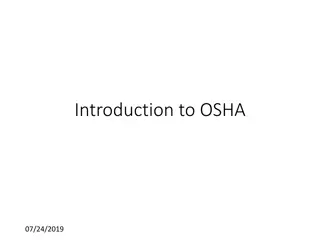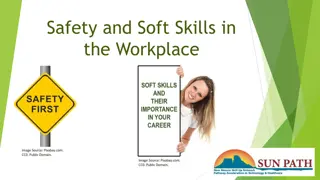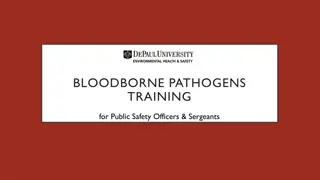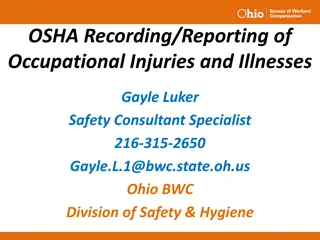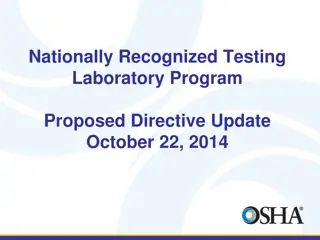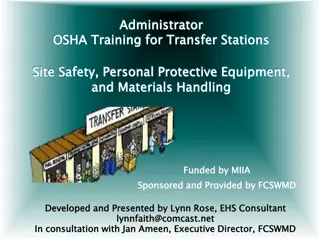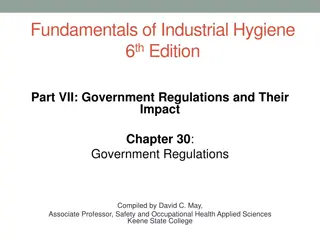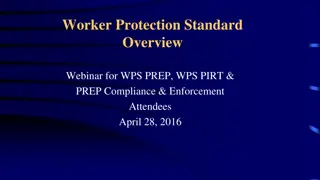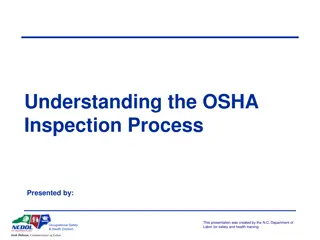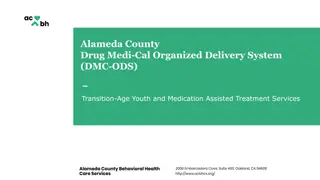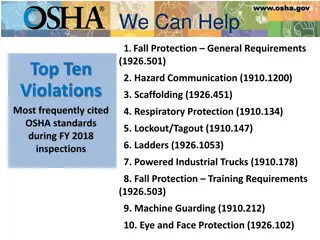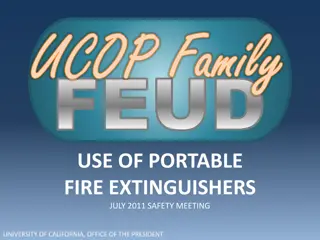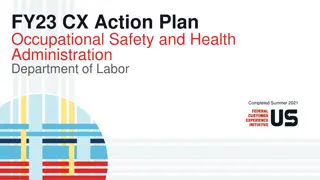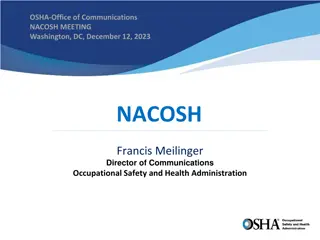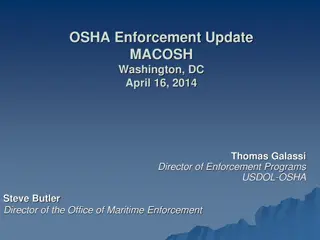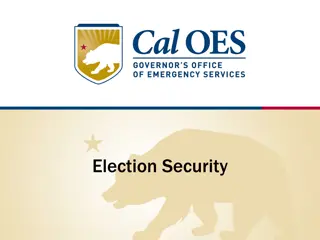Emergency Response Proposed Rule - Worker Safety and Health Conference
The Emergency Response Proposed Rule aims to update regulations for worker safety and health, expanding coverage to include technical search and rescue and emergency medical service entities. The rule proposes replacing the existing Fire Brigades standard with an Emergency Response standard. Federal
2 views • 23 slides
Does the 10 Hour OSHA Training Really Increase Your Knowledge About Safety
Workplace safety training covers rules, highlighting topics that have the most impact on worker safety, including those mandated by OSHA and some elective topics.
2 views • 2 slides
Challenges in Navigating the Medi-Cal System - Insights and Experiences
Medi-Cal coverage in California is comprehensive but complex to navigate, leading to difficulties in accessing needed care, especially for individuals with complex needs. The system includes mental health plans, managed care options, Medicare, and substance use services. Coordination challenges and
5 views • 17 slides
Insights on Outdoor Heat Exposure: OSHA Data Collection Pilot 2022
The Occupational Safety and Health Administration (OSHA) conducted a Data Collection Pilot from June to September 2022 to quantify outdoor heat exposure and assess employer heat illness prevention programs. Key findings include identifying elements of successful prevention programs, comparing workpl
0 views • 22 slides
Support for Low-Income Veterans Enrolled in Medi-Cal
The Medi-Cal program in California, the state's Medicaid program, provides coverage for over 16 million individuals, including children, pregnant women, seniors, and low-income adults. This program has seen a significant increase in enrollment since the implementation of the Affordable Care Act. Spe
0 views • 11 slides
Medi-Cal Managed Care Advisory Group Meeting - June 8, 2023
The Medi-Cal Managed Care Advisory Group Meeting scheduled for June 8, 2023, will focus on various topics including renewals/redeterminations, 2024 transition policy guide, transportation benefits, community health workers, and more. The meeting will feature key speakers providing insights and updat
0 views • 82 slides
Understanding OSHA: Importance, Rights, and Responsibilities
Learn about the importance of OSHA in ensuring worker safety, your rights under OSHA regulations, the responsibilities of employers, OSHA standards, inspection procedures, and where to seek help. Explore the history and mission of OSHA, and understand the key rights you have as a worker to a safe wo
0 views • 30 slides
Understanding OSHA Workplace Injuries Data Analysis
Analyze OSHA workplace injuries data from 2015 to 2017, including total recordable incident rates, number of injuries, total hours worked, city injury rates, and top locations with high injury rates. Explore the importance of using incident rates over total injury numbers and how departments benefit
0 views • 15 slides
OSHA Recordkeeping Guidelines Overview
This presentation provides an overview of OSHA's 29 CFR 1904 Recordkeeping Standard, emphasizing the importance of proper recordkeeping in the workplace. It covers topics such as the organization of the rule, the five-step process for determining recordability, and the distinction between Workers Co
0 views • 63 slides
Understanding OSHA: Training Topics and Responsibilities
Explore OSHA (Occupational Safety and Health Administration) through training topics covering its mission, standards, employer and worker responsibilities, enforcement, safety hazard reporting, and whistleblower protections. Discover the purpose of OSHA, its mission, and the importance of adhering t
0 views • 38 slides
Workplace Safety and OSHA Regulations for Phlebotomists
Learn about the importance of workplace safety and OSHA regulations for phlebotomists, including tips on cleanliness, following guidelines, and penalties for violations. It covers the critical need to prevent injuries and exposure to bloodborne illnesses in the workplace through proper practices and
0 views • 29 slides
Bloodborne Pathogens Training for Public Safety Officers & Sergeants
Bloodborne pathogens (BBPs) are pathogenic microorganisms found in human blood that can cause diseases like HIV, Hepatitis B, and Hepatitis C. Public safety officers and sergeants face occupational exposure to BBPs and should follow OSHA's BBP Standard to protect themselves. Training, vaccinations,
0 views • 41 slides
Understanding OSHA Bloodborne Pathogens Training and Hepatitis B Virus
Covering the basics of OSHA Bloodborne Pathogens Standard, this training material provides essential information on bloodborne pathogens, including Hepatitis B Virus (HBV). It emphasizes the importance of training for individuals with occupational exposure, outlining crucial topics such as Hepatitis
2 views • 56 slides
Techno-Economic Analysis of Calcium Looping Processes for Low CO2 Emission Cement Plants
This study explores the application of Calcium Looping (CaL) processes in cement plants to reduce CO2 emissions. The process involves using CaO as a sorbent to capture CO2 from flue gas, with the potential for integration at different points in the cement production process. The Tail-end CaL configu
3 views • 14 slides
OSHA Recording and Reporting Guidelines by Gayle Luker
Learn about OSHA's guidelines for recording and reporting occupational injuries and illnesses, as shared by safety consultant specialist Gayle Luker in Ohio. Understand the definitions of recordable and reportable events, the independence of OSHA injury recordkeeping and workers' compensation system
0 views • 25 slides
Proposed Updates to the Nationally Recognized Testing Laboratory Program
OSHA is proposing significant updates to the Nationally Recognized Testing Laboratory (NRTL) Program by aligning it with ISO standards, revising independence policies, and making major proposals to enhance the program. These changes aim to ensure stakeholders' views are considered and to improve the
0 views • 16 slides
OSHA Training for Transfer Stations: Site Safety and Materials Handling
This training session on OSHA requirements for transfer stations covers site safety, personal protective equipment, and materials handling. Developed and presented by EHS Consultant Lynn Rose in collaboration with FCSWMD Executive Director Jan Ameen, the training emphasizes work zone/site safety, PP
0 views • 46 slides
OSHA Requirements for Ladders: General Guidelines and Safety Measures
This document outlines the general requirements set by OSHA (Occupational Safety and Health Administration) for ladders to ensure safety in various work environments. It covers aspects such as ladder design, spacing, materials, inspection protocols, and permissible exceptions. Compliance with these
0 views • 28 slides
Comprehensive Guide to OSHA Respiratory Protection Training Program
Explore the OSHA requirements outlined in Part 1910.134 for respiratory protection training. Learn how to establish an OSHA-compliant program, differentiate between masks and respirators, and understand the functionalities and limitations of respirators. Discover the employer obligations in implemen
0 views • 26 slides
Overview of OSHA Act and Government Regulations in Industrial Hygiene
The OSHAct of 1970 aims to ensure safe working conditions and protect human resources. Key provisions empower the Secretary of Labor to issue standards and investigate violations. Employers and employees have specific duties outlined in the Act. OSHA coverage includes private sector employees, while
0 views • 34 slides
Overview of OSHA Proposed Rule Updates and Safety Standards
OSHA is proposing rule updates to improve worker safety by aligning standards with current industry practices and technology. The focus includes referencing ANSI B56.1-1969 for powered industrial trucks and complying with safety requirements from PCSA Standards. Additionally, the content covers the
0 views • 7 slides
Understanding Minnesota OSHA Compliance Regulations for Ergonomics Programs
Explore the guidelines and requirements outlined in the Minnesota Statutes for workplace ergonomics programs, focusing on key aspects such as employee safety, musculoskeletal health, and administrative considerations. Learn how to ensure compliance with OSHA regulations and create a safe working env
0 views • 53 slides
Worker Protection Standard Overview Webinar for WPS Compliance
Delve into the Worker Protection Standard (WPS) framework, revised rules, exemptions, and more in this comprehensive webinar tailored for WPS PREP, PIRT, and PREP Compliance and Enforcement attendees. Explore key aspects such as WPS basics, relationship with OSHA regulations, training requirements,
0 views • 120 slides
Guidelines for Implementing Ergonomics in the Workplace - Minnesota OSHA Compliance
Guidelines for implementing ergonomic practices in the workplace according to Minnesota OSHA compliance regulations. The document outlines requirements for assessing and addressing workplace ergonomics, including employee training, risk assessments, and compliance with state statutes. It also detail
0 views • 53 slides
Understanding OSHA Inspection Process: Safety Training Overview
This presentation, created by the N.C. Department of Labor, delves into the OSHA inspection process. It covers various inspection types, procedures, rights and responsibilities of employers and employees, and post-inspection processes. Key topics include amputations, inspection priorities, special e
0 views • 23 slides
Analysis of 2019 Cal MediConnect Rapid Cycle Polling Project Findings
The findings from the Cal MediConnect Rapid Cycle Polling Project conducted in 2019 focused on comparing the experiences of Cal MediConnect (CMC) enrollees by county, race, language, and disability across different characteristics such as language and need for Long-Term Services and Supports (LTSS).
0 views • 104 slides
OSHA Training Institute Overview
OSHA Training Institute provides essential introductory information on OSHA, covering topics such as the importance of OSHA, workers' rights, employer responsibilities, OSHA standards, inspection procedures, and available resources for assistance. The content highlights the significance of OSHA in i
0 views • 36 slides
Alameda County DMC-ODS Transitional Age Youth Services Overview
Alameda County Drug Medi-Cal Organized Delivery System (DMC-ODS) offers services for Transition-Age Youth (TAY) including medication-assisted treatment. Eligibility includes all Medi-Cal beneficiaries and specific clients like undocumented individuals ineligible for Medi-Cal. TAY are aged 16-24 and
0 views • 25 slides
Workplace COVID-19 Prevention Program Overview
Workplace COVID-19 Prevention Program (CPP) is essential to ensure employee health and safety by preventing COVID-19 exposure and spread. The program includes employee training, implementation of preventive measures, cleaning protocols, quarantine procedures, and return-to-work guidelines. Regular s
0 views • 17 slides
OSHA Top Ten Violations FY 2018 Summary
OSHA's Top Ten Violations in FY 2018 include Fall Protection, Hazard Communication, Scaffolding, Respiratory Protection, and Lockout/Tagout. Each category lists specific violations, emphasizing the importance of workplace safety and compliance with OSHA standards.
0 views • 12 slides
Dementia Cal MediConnect Project Overview
The Dementia Cal MediConnect Project, led by Debra Cherry, PhD, aims to create dementia-capable systems of care by improving patient detection and support for caregivers. The project is funded by various organizations and involves key components such as advocacy, care manager training, and health pl
0 views • 23 slides
Enhancing Medi-Cal and Covered California Transition Processes
Stakeholder meeting to discuss the seamless transfer of individuals between Medi-Cal and Covered California programs when losing coverage, seeking feedback on process development, leveraging technology for data sharing, and ensuring minimal impact on beneficiaries. Initiatives include Transfer of Co
0 views • 14 slides
Portable Fire Extinguisher Training and Guidelines
Annual portable fire extinguisher training is mandatory to comply with Cal/OSHA regulations. The training covers general principles of fire extinguisher use, when to use a portable fire extinguisher, and examples of different types of fires (Type A, B, C). It also outlines conditions when using a fi
0 views • 21 slides
OSHA Occupational Safety & Health Administration Action Plan Updates FY21-FY23
OSHA's recent reflections on capacity assessment for FY21 and action plan progress for FY23 reveal a focus on improving customer experience and data collection. While progress has been made in understanding customer needs and engagement, challenges remain in meeting schedule targets and enhancing fe
0 views • 10 slides
Understanding Confined Spaces and OSHA Standards
Explore the importance of confined space standards enforced by OSHA to protect workers from potential hazards. Learn about common confined spaces, identification criteria, and the concept of bodily entry. Discover why it's crucial to adhere to safety regulations in confined spaces to prevent acciden
0 views • 47 slides
OSHA Office of Communications - NACOSH Meeting Highlights and Resources
Explore the latest updates from the NACOSH meeting held in Washington, DC, on December 12, 2023. Learn about key personnel like Francis Meilinger, Director of Communications at OSHA, and access valuable resources, including social media links, video producer training series, language access tools, c
0 views • 9 slides
Understanding Medi-Cal Member Communication: Focus Group Results
The research aimed to assess the effectiveness of communication materials by the DHCS to inform Medi-Cal members about necessary actions during the continuous coverage unwinding period. Through focus groups and interviews, insights were gathered on awareness levels, preferred communication channels,
0 views • 23 slides
OSHA Enforcement Update - MACOSH Washington, DC Summary
OSHA's Enforcement Update discussed various initiatives including the Severe Violator Enforcement Program (SVEP), Novel Cases, and enforcement strategies for ergonomics and workplace violence. The presentation highlighted statistics on SVEP cases, novel enforcement cases, ergonomic inspections, and
0 views • 27 slides
Understanding the Role of Cal OES in Homeland Security and Emergency Management
Cal OES is a crucial agency within the Office of the Governor in California, overseeing homeland security and emergency management. With a team of 1,300 personnel, it administers billions of dollars in federal and state grants, operates key centers like STAC and Cal-CSIC, and plays a vital role in a
0 views • 6 slides
Cal Poly Budget Update and Planning Overview
This document provides an overview of Cal Poly's budget planning calendar for the 2019-20 fiscal year, including key milestones such as the release of the Governor's budget, negotiation processes, allocation planning, and final budget approvals. It also compares the California State University (CSU)
0 views • 15 slides

